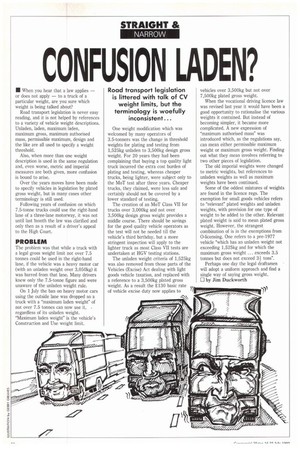CONFUSION LADEN?
Page 30

If you've noticed an error in this article please click here to report it so we can fix it.
Road transport legislation is littered with talk of CV weight limits, but the terminology is woefully inconsistent...
• When you hear that a law applies — or does not apply — to a truck of a particular weight, are you sure which weight is being talked about?
Road transport legislation is never easy reading, and it is not helped by references to a variety of vehicle weight descriptions. Unladen, laden, maximum laden, maximum gross, maximum authorised mass, permissible maximum, design and the like are all used to specify a weight threshold.
Also, when more than one weight description is used in the same regulation and, even worse, metric and imperial measures are both given, more confusion is bound to arise.
Over the years moves have been made to specify vehicles in legislation by plated gross weight, but in many cases other terminology is still used.
Following years of confusion on which 7.5-tonne trucks could use the right-hand lane of a three-lane motorway, it was not until last Month the law was clarified and only then as a result of a driver's appeal to the High Court.
PROBL EM The problem was that while a truck with a legal gross weight limit not over 7.5 tonnes could be used in the right-hand lane, if the vehicle was a heavy motor car (with an unladen weight over 3,050kg) it was barred from that lane. Many drivers knew only the 7.5-tonne figure and were unaware of the unladen weight rule.
On 1 July the ban on heavy motor cars using the outside lane was dropped so a truck with a "maximum laden weight" of not over 7.5 tonnes can now use it„ regardless of its unladen weight. "Maximum laden weight" is the vehicle's Construction and Use weight limit. One weight modification which was welcomed by many operators of 3.5-tonners was the change in threshold weights for plating and testing from 1,525kg unladen to 3,500kg design gross weight. For 20 years they had been complaining that buying a top quality light truck incurred the extra cost burden of plating and testing, whereas cheaper trucks, being lighter, were subject only to the MoT test after three years. Cheaper trucks, they claimed, were less safe and certainly should not be covered by a lower standard of testing.
The creation of an MoT Class VII for trucks over 3,000kg and not over 3,500kg design gross weight provides a middle course. There should be savings for the good quality vehicle operators as the test will not be needed till the vehicle's third birthday, but a more stringent inspection will apply to the lighter truck as most Class VII tests are undertaken at HGV testing stations.
The unladen weight criteria of 1,525kg was also removed from those parts of the Vehicles (Excise) Act dealing with light goods vehicle taxation, and replaced with a reference to a 3,500kg plated gross weight. As a result the £130 basic rate of vehicle excise duty now applies to vehicles over 3,500kg but not over 7,500kg plated gross weight.
When the vocational driving licence law was revised last year it would have been a good opportunity to rationalise the various weights it contained. But instead of becoming simpler, it became more complicated. A new expression of "maximum authorised mass" was introduced which, as the regulations say, can mean either permissible maximum weight or maximum gross weight. Finding out what they mean involves referring to two other pieces of legislation.
The old imperial weights were changed to metric weights, but references to unladen weights as well as maximum weights have been continued.
Some of the oddest mixtures of weights are found in the licence regs. The exemption for small goods vehicles refers to "relevant" plated weights and unladen weights, with provision for one type of weight to be added to the other. Relevant plated weight is said to mean plated gross weight. However, the strangest combination of is in the exemptions from 0-licensing. One refers to a pre-1977 vehicle "which has an unladen weight not exceeding 1,525kg and for which the maximum gross weight .. exceeds 3.5 tonnes but does not exceed 3i tons".
Perhaps one day the legal draftsmen • will adopt a uniform approach and find a single way of saying gross weight. LI by Jim Duckworth
















































































